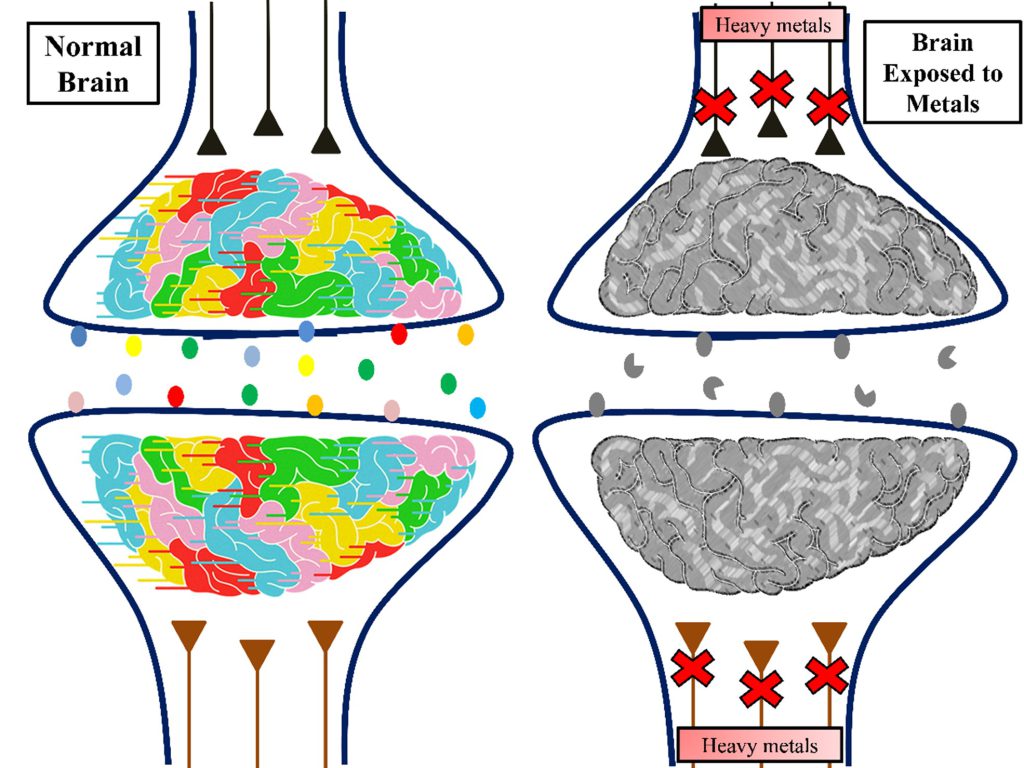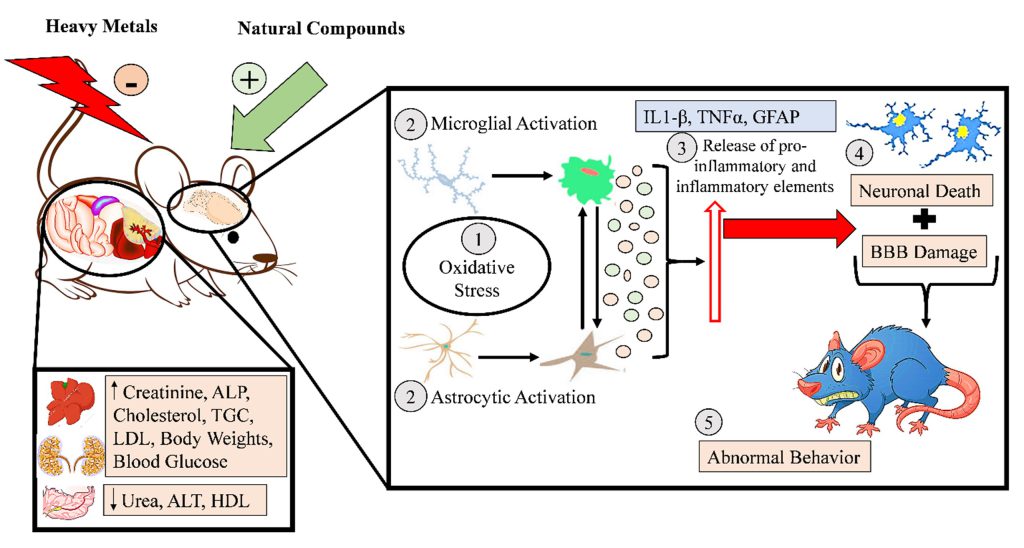In the complex tapestry of our environment, heavy metals play a multi-faceted role. They are essential for industry and technology, yet their accumulation poses an alarming risk to our well-being. The rise in industrial activities and urbanization has led to a surge in neurotoxic and heavy metals pollution, releasing these toxic elements into our air, water, and soil through industrial spills, vehicular emissions, agricultural runoff, and geological processes all contribute to the release of neurotoxic and heavy metals into our environment. Not only the developing countries, but the developed countries also have serious concerns of metals pollution and toxicity. The pollutants once were ignored, now stand among the top ten potentially toxic chemicals for human health. As these metals silently infiltrate our surroundings, their impact on human health, particularly neurological health has emerged as a crucial concern, emphasizing more research into the realm of heavy metal-induced neurotoxicity. Among these toxic metals, aluminum, arsenic, lead and cadmium, are ubiquitous pollutants causing wreak havoc on our most vital organ—the brain.

The brain is a marvel of evolution, a complex network of neurons and synapses that orchestrate our thoughts, emotions, and behaviors. Neurotoxic metals, through their toxic effects can disrupt brain intricate network. Their ability to traverse the blood-brain barrier grants them direct access to the control center of our bodies. Once inside, they can interfere with the delicate balance of neurotransmitters, disrupt cellular signaling, and induce oxidative stress, which can ultimately lead to neurodegenerative diseases and disorders like Alzheimer’s disease, Parkinson’s disease, Amyotrophic Lateral Sclerosis, Multiple Sclerosis, Schizophrenia, Bipolar Disorder and what not.
The research group of Dr. Touqeer Ahmed, considering the alarming levels of neurotoxic metals in Pakistani water and food resources, has been working for the past decade to understand the hazards of neurotoxic metals-induced neurotoxicity. By using different rodent models, they’ve uncovered a cascade of effects that neurotoxic and heavy metals can exert on the brain. They have found potential targets of these neurotoxic metals by studying various neurotransmitter receptors’, neuroinflammatory markers, and their associated genes. The lab has also studied the pharmacokinetics and behavioral effects of these neurotoxic metals. Their investigations into synaptic plasticity—the brain’s ability to adapt and learn—have revealed how neurotoxic metals impair this crucial process. As a result, learning and memory formation can suffer, potentially leading to cognitive deficits.

But the damage doesn’t stop there. Neurotoxic metals also intervene with the neurotransmitter receptors, differently associated with mood and behavior. The cholinergic and dopaminergic systems, responsible for regulating emotions and motivation were also effected by these metals exposure. The consequence? An increased susceptibility to anxiety, depression, and altered social behavior—a profound reminder that the effects of pollution extend far beyond the visible. By deciphering these genetic pathways, they’ve gained a deeper understanding of how neurotoxic metals trigger inflammation, potentially laying the groundwork for targeted interventions.
The lab has also studied beneficial effects of many natural compounds on metals induced neurotoxicity. Pakistan is an agricultural country, and a huge part of its economy is based on its agricultural production. Apart from economic growth and food production, many natural plants are a great source of anti-inflammatory and antioxidant compounds which can play a huge role in alleviating these neurological deficits within the limited financial resources of the people, with no to low side-effects.

As we stand at the crossroads of environmental concerns and neurological health, the intricate dance between neurotoxic metals and our brains continues to unfold. The studies undertaken by our Neurobiology lab paint a comprehensive picture of the detrimental impact these toxic elements can have on synaptic function, neurotransmitter receptors, and ultimately, on behavior and cognition. Our collective understanding of neurotoxic metals-induced neurotoxicity propels us towards a future where awareness drives action. By delving deeper into the mechanisms that govern these effects, we pave the way for informed policies and proactive measures to curtail neurotoxic metals pollution and its protective measures. As we continue our pursuit of knowledge, we remain dedicated to safeguarding our most precious resource—the human brain—from the silent intruders that threaten its vitality.
References:
- Ishaq, S., Liaqat, A., Hameed, A. & Ahmed, T. 2021. Biochemical mechanisms of aluminium and other metals exposure, their brain entry mechanisms, effects on blood brain barrier and important pharmacokinetic parameters in neurological disorders. Biochem. Mech. Alum. Induc. Neurological Disord, 1.(1-32)
- Ishaq, S., Siyar, S., Basri, R., Liaqat, A., Hameed, A. & Ahmed, T. 2023. Neuroprotective Effects of Shogaol in Metals (Al, As and Pb) and High-fat diet-induced Neuroinflammation and Behavior in Mice. Current Molecular Pharmacology, 16, 725-750.
The author is a Tenured Professor at the Atta-ur-Rahman School of Applied Biosciences (ASAB), National University of Sciences and Technology (NUST), Islamabad- Pakistan. He can be contacted at [email protected].
Google Scholar Profile: https://shorturl.at/BETZ5

![]()







